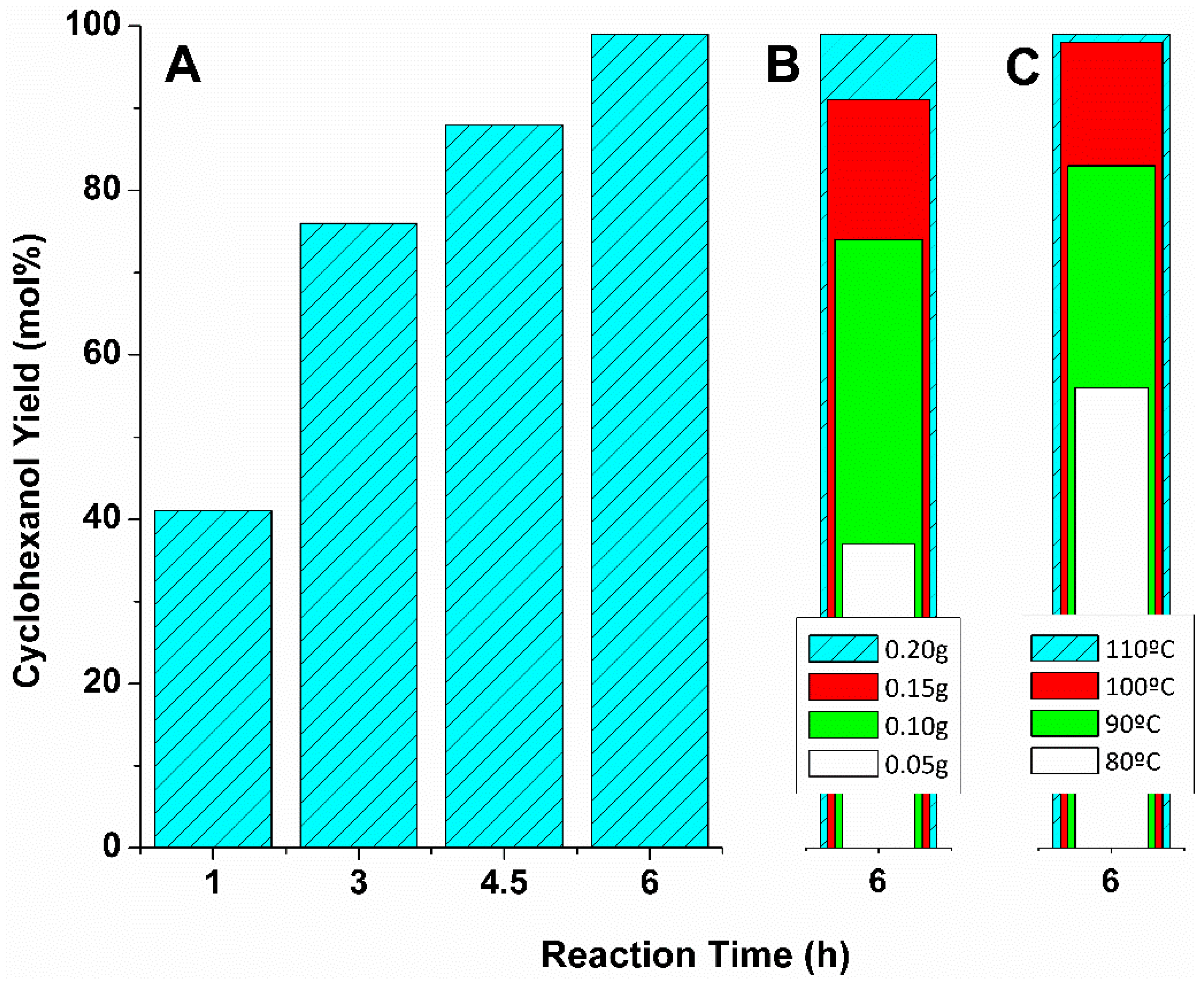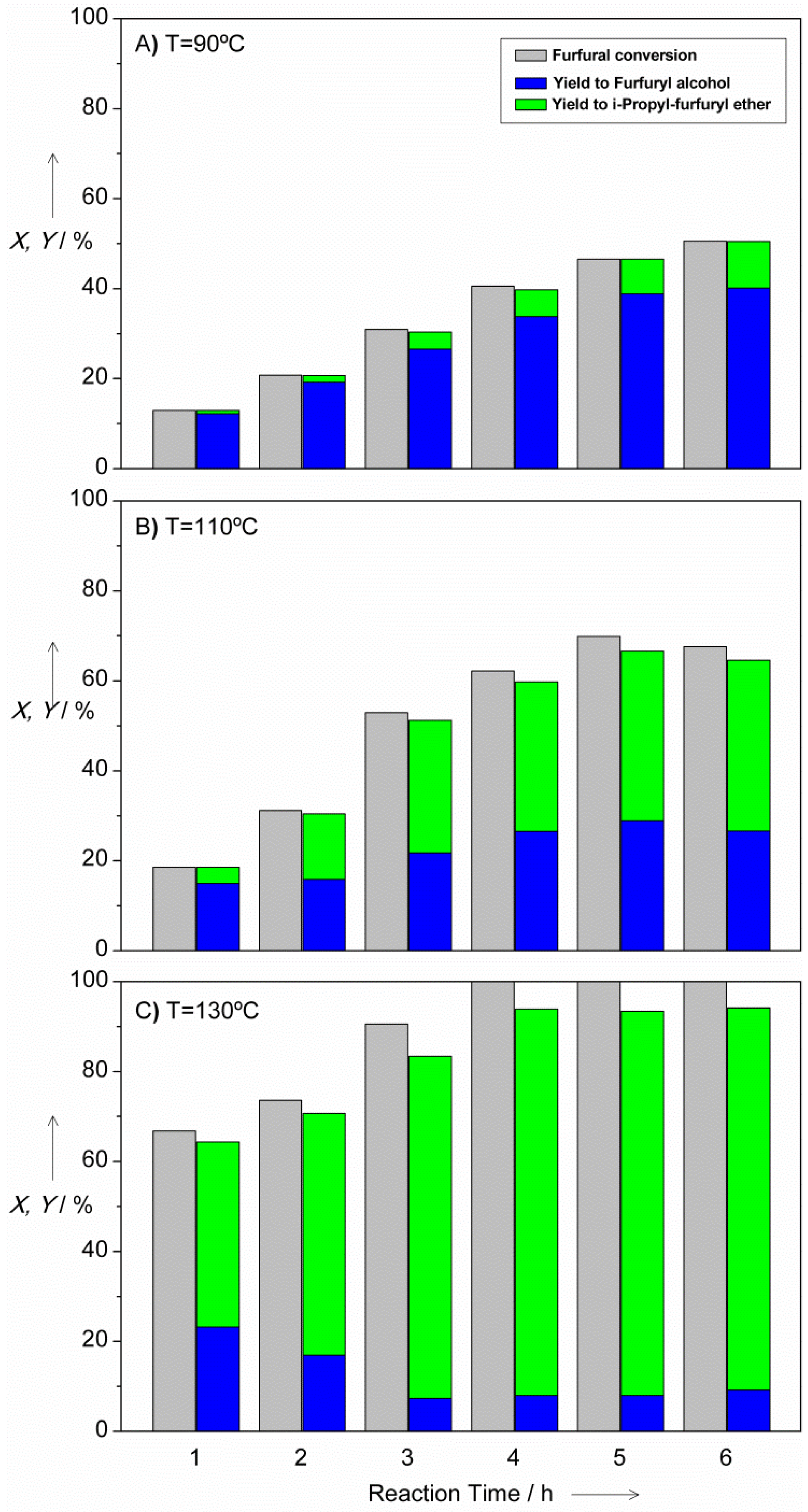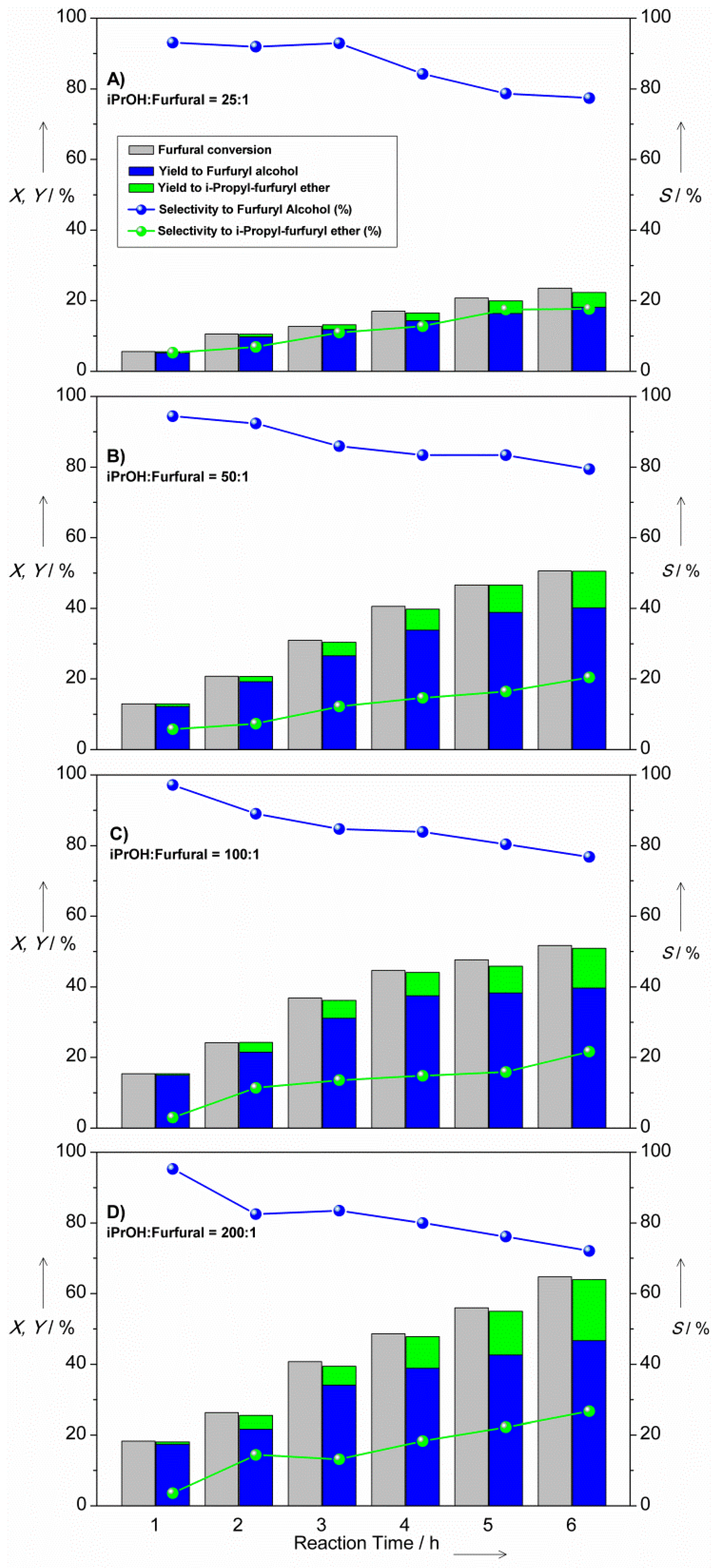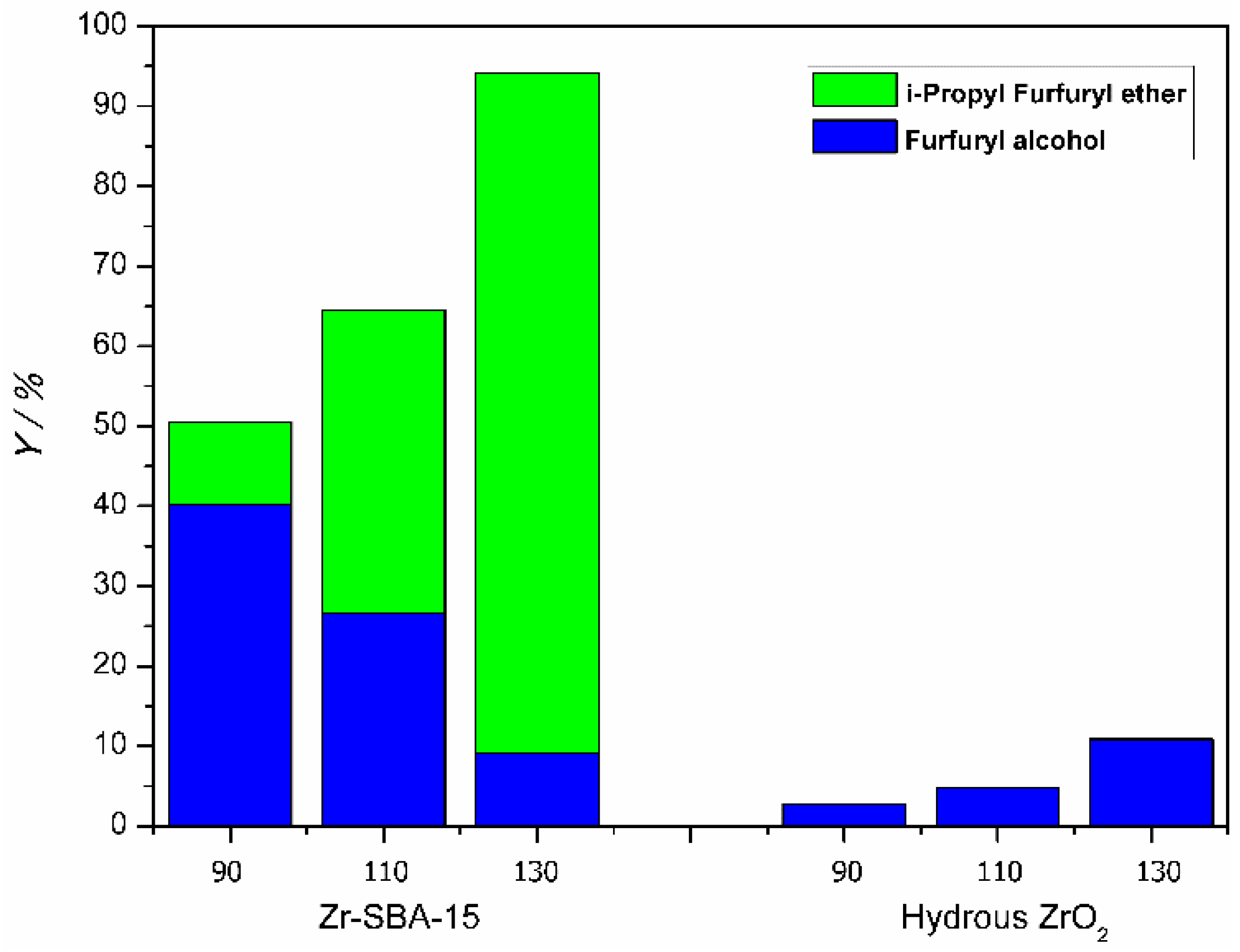2.1. MPV Reduction of Cyclohexanone
The activity of Zr-SBA-15 materials in MPV reactions was first evaluated through the assessment of their catalytic activity in the reduction of cyclohexanone to cyclohexanol. In order to get a deeper understanding of the performance of this catalyst, the influence of the catalyst loading and the reaction temperature were studied.
Figure 2 depicts the results achieved in the MPV reduction of cyclohexanone with
i-PrOH. Selectivity of the transformation was, in every case, close to 100%, since no by-products were detected under the tested reaction conditions. As for the catalytic behavior of Zr-SBA-15, this evidenced a positive net influence in the conversion of the ketone towards cyclohexanol, as compared to a blank reaction test, performed in absence of catalyst, where negligible substrate conversion was detected. The analysis of the kinetic data (
Figure 2A) suggests that the acceleration driven by the Zr-SBA-15 material is high enough to ensure an almost complete conversion of the substrate into the desired product in just 6 h. The high substrate conversion obtained in presence of these materials seems, however, to be a consequence of the use of a quite high amount of catalyst in the reaction media (catalyst to substrate mass ratio = 1.0). Product yield is largely influenced by the amount of catalyst, as it is evident from the results achieved when using different substrate to catalyst mass ratios (4.0–1.0; catalyst loadings of 0.05–0.20 g;
Figure 2B). In this way, reducing the catalyst loading in the reaction media to 0.05 g (substrate:catalyst mass ratio of 4.0) led to a significant decreasing in product yield, though 37% of total amount of substrate was transformed into cyclohexanol. This behavior could be linked to the high amount of sacrificing alcohol in the reaction media. The interaction of the secondary alcohol with the catalytically active zirconium sites could lead to the saturation of the metal coordination sphere, reducing its ability to bind the ketone substrate, thus decreasing the intrinsic catalytic activity [
22,
29,
30]. This influence is much more pronounced as the catalyst loading decreases because of the higher proportion of sacrificing alcohol to catalyst.
As for the influence of the reaction temperature, decreasing this parameter (
Figure 2C) yields, as expected, lower amounts of the reaction product. Nevertheless, for the considered reaction time 6 h, 100 °C is suitable to provide 98% of cyclohexanol, so that, higher temperature conditions are not required to drive this transformation further.
For comparison purposes, two reference catalytic tests, carried out in presence of zircon and zirconium dioxide, were accomplished. Zircon and hydrous zirconia were selected because of their presence in the Zr-SBA-15 material, as stated from XRD, to ensure their catalytic capability in MPV reactions and assess their influence in that shown by Zr-SBA-15. Both materials produced negligible substrate conversion or product yields, under the tested reaction conditions (
T = 110 °C,
t = 6 h; substrate to catalyst mass ratio = 1.0), indicating that the catalytic activity of Zr-SBA-15 comes not from the presence of these crystalline dense phases of zirconium silicate and hydrous zirconia, but from other types of zirconium species, placed at accessible locations onto the surface of the mesostructured material. The catalytic sites can be present either as isolated zirconium sites or as zirconium-oxygen-zirconium species [
28], which have been proved, both of them, to be catalytically active in Lewis-acid driven reactions [
31].
Figure 2.
Reaction results from the MPV reduction of cyclohexanone with i-PrOH in presence of Zr-SBA-15. (A) Influence of the reaction time. Temperature: 110 °C; Catalyst loading: 0.2 g; i-PrOH to cyclohexanone molar ratio: 50; Cyclohexanone to catalyst mass ratio: 1.0. (B) Influence of the catalyst loading. Reaction time: 6 h. (C) Influence of the reaction temperature. Reaction time: 6 h; Catalyst loading: 0.2 g.
Figure 2.
Reaction results from the MPV reduction of cyclohexanone with i-PrOH in presence of Zr-SBA-15. (A) Influence of the reaction time. Temperature: 110 °C; Catalyst loading: 0.2 g; i-PrOH to cyclohexanone molar ratio: 50; Cyclohexanone to catalyst mass ratio: 1.0. (B) Influence of the catalyst loading. Reaction time: 6 h. (C) Influence of the reaction temperature. Reaction time: 6 h; Catalyst loading: 0.2 g.
Table 1 lists the results obtained in the reduction of different ketones with a variety of secondary alcohols, looking for the influence of the different substituents in both reactants on the catalytic behavior of Zr-SBA-15. Thus, in a first set of experiments, different secondary alcohols have been assayed in the reduction of cyclohexanone (entries 1–4). Increasing the size of the secondary alcohol leads to lower conversion rates, as it is inferred from the lower product yield obtained in the reduction of cyclohexanone insofar as the alkyl chain in the sacrificing alcohol increases. However, when using 2-methyl-cyclohexanol as secondary alcohol (entry 4), a higher product yield is obtained (71%), probably as a consequence of the more accessible conformation of the carbonyl group in the cyclic ketone. As for the influence of the structure of the ketone substrate (entries 5–7), higher reaction rates are detected for the smaller molecules (2-butanone compared to penta- and hexanone), being the presence of steric hindrances around the carbonyl group, and the subsequent difficulty in the coordination of the same to the zirconium catalytically active sites, the most probable causes of lower activities. In this way, 2-butanone is almost quantitatively transformed into its corresponding alcohol, whereas 2-methyl-cyclohexanone is scarcely reduced (8%).
Ethyl levulinate and furfural have also been tested as substrates in these preliminary MPV tests (
Table 1, entries 8 and 9). In the first case, the reduction of the carbonyl group at ethyl levulinate leads to the production of 4-hydroxy-ethyl valerate, which evolves through an intramolecular transesterification pathway towards γ-valerolactone (GVL), decreasing the selectivity of the process to the desired alcohol (42%). On the other hand, the low reaction rate observed for this substrate could be attributed to the presence of the carboxylate group in the ester moiety, which can lead to different molecular adsorption modes on the zirconium sites [
32] either through the carbonyl or through the carboxylic acid group. In this way, the former is favorable to MPV conversion, whereas the latter is not, yielding only 24% of the desired alcohol product.
As for the reduction of furfural, in contrast with the results provided by other authors for the reduction of aldehydes in presence of similar catalytic systems to those applied hereby [
22,
33], furfural is converted in a lower extension, as compared to the other tested molecules, into its corresponding alcohol, probably as a consequence of two different reasons: the lower reactivity of the carbonyl group due to the electron donating nature of the furan ring, and the planar adsorption mode of the same onto the support surface silanol groups [
34] thus leading to a competition with the adsorption on zirconium active sites and reducing the MPV reaction rate. However, the high interest for furfuryl alcohol, which serves as starting material in numerous organic syntheses [
35] and the simplicity of the catalytic system, has prompted us to investigate the influence of several operation parameters looking for the best reaction conditions to enhance this transformation.
Table 1.
Results from MPV catalytic tests in presence of Zr-SBA-15.
Table 1.
Results from MPV catalytic tests in presence of Zr-SBA-15.
| Entries | Sacrificing alcohol | Substrate | Product yield (mol %) |
|---|
| 1 | 2-Propanol | Cyclohexanone | 99 |
| 2 | 2-Butanol | Cyclohexanone | 97 |
| 3 | Cyclopentanol | Cyclohexanone | 24 |
| 4 | 2-methyl cyclohexanol | Cyclohexanone | 71 |
| 5 | 2-Propanol | 2-Butanone | 85 |
| 6 | 2-Propanol | Cyclopentanone | 21 |
| 7 | 2-Propanol | 2-methyl cyclohexanone | 8 |
| 8 | 2-Propanol | Ethyl levulinate | 42 a |
| 9 | 2-Propanol | Furfural | 24 |
2.2. MPV Reduction of Furfural
The study of the catalytic performance of Zr-SBA-15 catalyst in the MPV reduction of furfural has been investigated by using
i-PrOH as sacrificing alcohol to produce furfuryl alcohol. For this purpose, different reaction parameters have been assayed: the reaction time, the reaction temperature, and the sacrificing alcohol to substrate molar ratio.
Figure 3 depicts the influence of the reaction temperature, as a function of time, on the conversion of furfural and the yield towards the detected products present in the reaction media. First thing to emphasize is that furfural is converted in high extension only if the applied reaction temperature is raised from 90 up to 130 °C. Under these conditions (130 °C), furfural is completely converted after 4 h of reaction. However, the existence of side reactions leads to the formation of undesired by-products such as that coming from the etherification between furfuryl alcohol and the sacrificing alcohol (
i-propyl-furfuryl ether), which is also present in the reaction media. Alcohol etherification is usually accomplished by the reaction in the presence of mild acid catalysts [
36,
37], and bearing in mind that a blank reaction performed by heating a solution of furfuryl alcohol in
i-PrOH not shown, does not lead to the formation of the ether product, Zr-SBA-15 material necessarily plays a crucial role in the assembly of this chemical from furfuryl alcohol. However, the influence of the catalyst seems to be, though necessary, also limited, since the assays performed under different temperature conditions lead to very different yields towards furfuryl alcohol and
i-propyl-furfuryl ether. Thus, the former appears as the main product only at low temperatures (90 °C,
Figure 3A), reaching a product yield of 41%, for a substrate conversion of 54% after 6 h of reaction. Under these conditions, only 15% of the starting furfural is converted into the ether by-product. Increasing the reaction temperature up to 110 °C does not improve the production of the target product, obtaining a furfuryl alcohol yield (29%) lower than that achieved at 90 °C, and being the amount of produced
i-propyl-furfuryl ether much higher (38%). In this way, insofar as the reaction temperature is increased, the yield to
i-propyl-furfuryl ether is also enhanced, becoming the main reaction product at 130 °C (85%), and providing a poor 9% yield towards furfuryl alcohol.
Results obtained from experiments performed at different temperatures have been used to perform a kinetic study of the identified reactions by formulating a pseudo-homogeneous first-order kinetic model (Equations (1)–(3),
Supplementary Information) for both chemical transformations, the reduction of furfural and the etherification of furfuryl alcohol with the hydrogen-donor solvent 2-propanol. This model was fitted to the experimental data by means of non-linear regression, applying the simplex optimization method, to find the optimal values for the kinetic constants, minimizing the sum of squares error, which has been used as objective function (Equation (4),
Supplementary Information). In this function, the error was defined as the difference between the experimental value of concentration for each reaction time and the predicted concentration value for the different products involved in the proposed reaction scheme.
The kinetic model fitted quite fine to the experimental concentration values obtained for each compound during the overall reaction temperatures (
Figure S1, Supporting Information). Thus, the obtained kinetic constants for the different assayed reaction temperature values were fitted to an Arrehnius model, providing the pre-exponential and apparent activation energy values for each reaction (
Table S1, Supplementary Information). The results reveal that the fastest reaction is that corresponding to the etherification of the MPV reaction product, which is, in addition, more sensitive to the reaction temperature as compared to the MPV transformation of furfural, which is congruent with the results previously described as well as with the higher reactivity reported for furfuryl alcohol, as compared to furfural.
Figure 3.
MPV reduction of furfural with i-PrOH in presence of Zr-SBA-15—Influence of the reaction temperature. Reaction Conditions: Catalyst loading: 0.2 g; i-PrOH to furfural molar ratio: 50; furfural to catalyst mass ratio: 1.0; X = Substrate conversion; Y = Product Yield.
Figure 3.
MPV reduction of furfural with i-PrOH in presence of Zr-SBA-15—Influence of the reaction temperature. Reaction Conditions: Catalyst loading: 0.2 g; i-PrOH to furfural molar ratio: 50; furfural to catalyst mass ratio: 1.0; X = Substrate conversion; Y = Product Yield.
As for the influence of the sacrificing alcohol to substrate molar ratio on the catalytic performance of Zr-SBA-15 material in the MPV reduction of furfural, this has been assessed in the range 25:1–200:1. Furfural conversion and yields (left axes) and selectivities (right axes) towards the different products have been depicted in
Figure 4. As in the previously described assays,
i-propyl-furfuryl ether is produced together with furfuryl alcohol under all the tested experimental conditions, as a consequence of the etherification of the same with the sacrificing alcohol. In terms of product yield, the influence of the
i-PrOH:Furfural molar ratio is positive for the production of furfuryl alcohol.
Figure 4.
MPV reduction of furfural with i-PrOH in presence of Zr-SBA-15—influence of the sacrificing alcohol to substrate molar ratio. Reaction Conditions: Catalyst loading: 0.2 g; reaction temperature: 90 °C; furfural to catalyst mass ratio: 1.0; i-PrOH to furfural molar ratio: (A) 25:1, (B) 50:1; (C) 100:1; (D) 200:1. (X = Substrate conversion; Y = Product Yield; S = Selectivity towards the product).
Figure 4.
MPV reduction of furfural with i-PrOH in presence of Zr-SBA-15—influence of the sacrificing alcohol to substrate molar ratio. Reaction Conditions: Catalyst loading: 0.2 g; reaction temperature: 90 °C; furfural to catalyst mass ratio: 1.0; i-PrOH to furfural molar ratio: (A) 25:1, (B) 50:1; (C) 100:1; (D) 200:1. (X = Substrate conversion; Y = Product Yield; S = Selectivity towards the product).
Thus, a poor conversion of furfural is achieved (24%) for the lower amount of
i-PrOH present in the reaction media (
i-PrOH:Furfural = 25:1,
Figure 4A), yielding 18% of furfuryl alcohol with a low production of
i-propyl-furfuryl ether. Increasing the amount of sacrificing alcohol in the reaction media, as previously observed for cyclohexanone, progressively enhances the production of the target product, up to yield 45% of the starting furfural as furfuryl alcohol (
Figure 4D), when using a sacrificing alcohol to substrate molar ratio of 200. The production of
i-propyl-furfuryl ether follows a similar trend to that observed for furfuryl alcohol with the amount of
i-PrOH in the reaction media.
Thus, a higher production of this by-product is observed as the
i-PrOH:Furfural molar ratio increases, which is not only due to a higher concentration of furfuryl alcohol in the reaction media, but also because a higher quantity of
i-PrOH drives faster the etherification of the target product, which is inferred from the steeper slopes in the selectivity curves (
Figure 4, right axes) . However, the influence of
i-PrOH:Furfural molar ratio seems to be limited as compared to that observed for the reaction temperature. Thus, under the most favorable conditions (
i-PrOH:Furfural molar ratio of 200),
i-propyl-furfuryl ether production reaches maximum yields around 14%, which involves a maximum selectivity towards this product of 27%. These values are quite low in comparison to those obtained when increasing the reaction temperature
i-propyl furfuryl ether becomes the major product at 110 °C, supporting the fact that the influence of the reaction temperature is, in this case, much higher than the proportion of the different reactants involved in the MPV transformation.
From the previous results it can be concluded that low reaction temperatures (≤90 °C) as well as high i-PrOH:Furfural molar ratios (≥200:1) are required to maximize the production of furfuryl alcohol by MPV reduction of furfural in presence of the Zr-SBA-15 material. However, the formation of i-propyl-furfuryl ether as a by-product seems to be inevitable when furfuryl alcohol is present in a practical concentration in the reaction media, leading to the decrease of the achieved yield towards the desired product. However, this by-product finds interesting applications as biofuel additive, so that its production could also provide benefits.
Nevertheless, regarding the catalytic activity of Zr-SBA-15 in the studied transformation, it must be noted that, although either increasing the reaction temperature, or the
i-PrOH:Furfural molar ratio, leads to the consumption of furfuryl alcohol in favor of
i-propyl-furfuryl ether, there are important features that support the good performance of Zr-SBA-15 as catalyst for the MPV reduction of furfural. Thus, the existence of
i-propyl-furfuryl ether is only a consequence of the prior formation of furfuryl alcohol in a very fast manner—much faster as the reaction temperature increases, which obviously involves the MPV reduction of furfural. In this way, if furfuryl alcohol and
i-propyl-furfuryl ether are considered together as products coming from the MPV reduction of the substrate, an outstanding combined yield of 94% (94% selectivity) towards furfural-reduction-derived products is obtained when operating at 130 °C. This involves a second feature that evidences the good catalytic behavior in MPV reactions, which is the absence of secondary by-products—obtained from side-reactions such as the acetalization of furfural [
38], which is produced by reaction of furfural with alcohols in presence of weak acid catalysts. Remarkably, these a priori plausible by-products are absent in the reaction media even when operating with the maximum quantity of sacrificing alcohol, supporting the good selectivity of the Zr-SBA-15 catalysts towards H-transfer reactions.
A comparison between Zr-SBA-15 and hydrous zirconia, a typical catalyst used in MPV transformations, has been established. This comparison was performed in order to determine whether the mesostructured catalyst involves, or not, catalytic advantages over the conventional catalyst to convert furfural into furfuryl alcohol through a MPV reduction.
Figure 5 shows the results in terms of product yield at 3 different temperatures: 90, 110 and 130 °C. Unlike Zr-SBA-15, hydrous ZrO
2 provided increasing furfuryl alcohol yields with temperature, although the achieved values were very poor, even at 130 °C, yielding ~11% of furfuryl alcohol, and evidencing a much lower catalytic activity than Zr-SBA-15 material.
Figure 5.
MPV reduction of furfural with i-PrOH—catalyst screening. Reaction Conditions: Catalyst loading: 0.2 g; reaction temperature: 90–110–130 °C; furfural to catalyst mass ratio: 1.0; i-PrOH to furfural molar ratio: 50; reaction time: 6 h.
Figure 5.
MPV reduction of furfural with i-PrOH—catalyst screening. Reaction Conditions: Catalyst loading: 0.2 g; reaction temperature: 90–110–130 °C; furfural to catalyst mass ratio: 1.0; i-PrOH to furfural molar ratio: 50; reaction time: 6 h.
The low catalytic activity shown by the hydrous zirconia could be ascribed to the low textural properties of this material. Despite the zirconium content is higher in hydrous ZrO2 than in Zr-SBA-15, its lower surface area (~10 m2/g) limits the extent of the reaction interface, so that a low conversion of the substrate into furfuryl alcohol is achieved. However, the most interesting difference between Zr-SBA-15 and hydrous zirconia catalysts can be the absence of the by-product furfuryl-isopropyl ether—when using hydrous ZrO2. This difference between both materials could be ascribed to lower acidity of hydrous ZrO2, as compared with Zr-SBA-15. The high dispersion achieved for zirconium species in Zr-SBA-15 material leads to a great extension of the reaction interface, leading to a higher catalytic activity, but also to the presence of isolated zirconium species, which are associated to the occurrence of acid sites. These sites are the responsible for the transformation of furfuryl alcohol into furfuryl-isopropyl ether. Since these are absent in hydrous zirconia, this material is inactive in the etherification reaction, even if high temperature values are applied.
Finally, γ-alumina—a common Lewis-acid catalyst used in MPV transformations—was also used as reference catalysts. In this case, unlike hydrous zirconia, γ-alumina provided furfuryl alcohol yield of 52% after 6 h at 90 °C (Catalyst loading: 0.2 g; furfural to catalyst mass ratio: 1.0; i-PrOH to furfural molar ratio: 50), a comparable result to that shown by Zr-SBA-15. Nevertheless, if considering the completely different metal loading shown by g-alumina and Zr-SBA-15 material, the results, as in the case of hydrous zirconia, confirm a superior intrinsic catalytic activity in the mesostructured material, probably as consequence of the better catalytic performance of isolated zirconium species as compared to bulk zirconia or bulk aluminum oxide-based materials.
In order to check the reusability of Zr-SBA-15 material, recycling tests were performed for four consecutive reaction tests, involving intermediate washing with solvents between recycling tests 1 and 2, and reactivation by calcination for the rest of the recycling tests (
Figure S2; Supporting Information). Results evidence a strong catalytic activity decay from the first to the second consecutive reaction runs, probably as consequence of deposition of products and product intermediates onto the catalytic sites, thus preventing the access of new reactant molecules. Intermediate washing was applied between the reaction tests accomplished in presence of the fresh catalyst and the first recycling test. In this way, some of the organic compounds deposited onto the catalytic centers could remain adsorbed even after the washing treatment, thus leading to catalytic activity decay. On the contrary, intermediate calcination, which was applied for the rest of the study on the reusability of the Zr-SBA-15 material, allowed, though not fully, a partial recovering of the initial catalytic activity. However, this seemed to be stabilized between the second and the third recycling tests. These results suggest that the starting Zr-SBA-15 material contain some unstable catalytic sites, which are loss during the first assay, and afterwards, the material shows quite a stable behavior, though calcination has to be applied between consecutive reaction runs in order to completely remove organic deposits from the catalysts.













